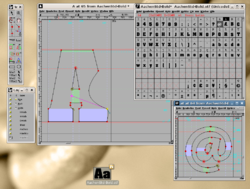
Type design
Encyclopedia

Typeface
In typography, a typeface is the artistic representation or interpretation of characters; it is the way the type looks. Each type is designed and there are thousands of different typefaces in existence, with new ones being developed constantly....
s.
History
Although the technology of printing text using movable type was invented in China, and despite the esteem which calligraphyCalligraphy
Calligraphy is a type of visual art. It is often called the art of fancy lettering . A contemporary definition of calligraphic practice is "the art of giving form to signs in an expressive, harmonious and skillful manner"...
held in that civilization, the vast number of Chinese characters meant that few distinctive, complete fonts could be afforded by Chinese printers. For many centuries, creating type started with cutting punches, which acted as the masters. The material that was cut formed a prototype of the character from which type was cast by various means from an alloy usually containing lead. Type design accounted for the limitations of the printing process, such as the splashing properties of ink or the wear on the type itself. In many countries, though not the United States of America, type design could be copyrighted typeface by typeface. The USA offered and continues to offer design patents as an option for typeface design protection.
For the American Type Founders Corporation, and a few others using their technology, each character was drawn in a very large size, over a foot (30 cm) high. The outline was then traced by a Benton pantograph
Pantograph
A pantograph is a mechanical linkage connected in a special manner based on parallelograms so that the movement of one pen, in tracing an image, produces identical movements in a second pen...
-based engraving machine with a pointer at the hand-held vertex and a cutting tool at the opposite vertex down to a size usually less than a quarter-inch (6 mm). The pantographic engraver was first used to cut punches, and later to directly create matrices.
With the coming of computers, especially those on artists' desktops, type design eventually became a subdivision of computer graphics, employing a drafting program of some sort. Today, visual animators can create complex movies using just fonts. This style is called kinetic typography. Each character design can be traced by a stylus on a digitizing board, or modified from a scanned drawing of somewhat smaller size than that once used for the pantograph, or composed entirely within the computer graphics program itself. Each character is then made into a digitized form to be reconstructed within the graphics display program of a display screen or printer. Copyright was extended to this form. Although a given digitization of a typeface can all too easily be modified by another type designer, such a modified font is usually considered a derivative work
Derivative work
In United States copyright law, a derivative work is an expressive creation that includes major, copyright-protected elements of an original, previously created first work .-Definition:...
, and is covered by the copyright of the original font software.
Principles
Regardless of the method used to specify type design, characters of different sizes have slightly different shapes for improved clarity and, above all, artistic consistency. There are many subtleties of shape so that no character looks too small or large.Profession
Type design is performed by a type designer. Although recently there have been many amateur typefaces available on CDs in batches of hundreds, type design remains an artistic profession of applied art comparable with architecture.Industrial art
Type design, along with architecture, is one of the arts in which the concept of postmodernismPostmodernism
Postmodernism is a philosophical movement evolved in reaction to modernism, the tendency in contemporary culture to accept only objective truth and to be inherently suspicious towards a global cultural narrative or meta-narrative. Postmodernist thought is an intentional departure from the...
best figures. The "modern" period of type design was the mid-twentieth century, during which sans-serif typefaces were supposed to be superior to all others due to their stark rationality. But later, scientific study revealed that people could read serif typefaces faster and with greater accuracy. Suddenly, in the 1960s, professional typefaces started to appear that were not intended to be supremely readable, just in a style that was fashionable. One example is Aldo Novarese
Aldo Novarese
Aldo Novarese was an Italian type designer who lived and worked mostly in Turin where he produced an impressive number of unique designs.-Training and Career:...
's 1971 typeface named Stop, which was used in various science fiction movies in the 1970s.
Further reading
- Stiebner, Erhardt D. & Dieter Urban. Initials and Decorative Alphabets. Poole, England: Blandford Press, 1985. ISBN 0713716401

